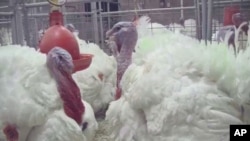Roughly 45 million turkeys will be served across the United States on Thanksgiving Day, November 25. But the turkey we eat today is not the same one that was consumed by the pilgrims in the 17th century. Today's turkey - large and mostly white - is the result of years of research at the US Department of Agriculture where scientists have now sequenced the genome for the domesticated turkey. Producer Zulima Palacio prepared this little-known story that many Americans might prefer not to hear.
These turkeys only slightly resemble their ancestors: wild turkeys the American pilgrims feasted on at their first Thanksgiving in 1621. Those turkeys weighed no more than 6 kilograms. Today these males, called Toms, can weigh up to 36 kilos.
"The wild turkey is pretty scrawny compared to today's birds," said Dr. Julie Long, a leading scientist on turkey reproduction at the Agriculture Research Service of the US Department of Agriculture. "Through natural selection, the turkey breeders have developed turkeys that have very large breast muscle, and they grow very large."
That selection began decades ago when consumers started favoring bigger birds with more breast meat. By the 1960s, the poultry industry had begun to artificially inseminate so-called "broad breasted white" turkeys.
"All of the turkeys in the US are produced with artificial insemination, and it takes a lot of time," added Long.
Artificial insemination of turkeys became required for many reasons. One is productivity. The other has to do with weight. Watch these turkeys. The smaller one in the front is the female, about 11 kilos. The large ones in the back are males, more than double her weight at 32 kilos. As the males grew larger breasts, that interfered with their ability to mate.
"If they did not perform artificial insemination, the turkey industry will begin to wane. Fertility through natural mating is very low," noted Murray Bakst, an expert on reproduction in birds at the USDA. He says turkey, a good source of protein, has become a fast growing international industry.
"Right now in the industry, the incubation capacity is huge. Hatcheries will hatch a million eggs in a week," added Bask.
In just one day, on November 25, 45 million turkeys will be served for the traditional Thanksgiving meal.
At the research facilities of the Department of Agriculture, the incubator can hold hundreds of eggs. Sue Rosoff manages the hatchery.
"The turkey eggs stay here for 25 days and on the 25th day we transfer them to the hatchers in the other room," said Rosoff.
These chicks are being closely monitored for research on the effectiveness of artificial insemination and their resistance to disease. Recently, the USDA and 28 other institutions finished mapping the turkey genome.
"The turkey genome is basically like a road map or a textbook to the turkey," explained long.
Using the genetic map, turkeys may be further fine tuned to feed a human population growing every day.











